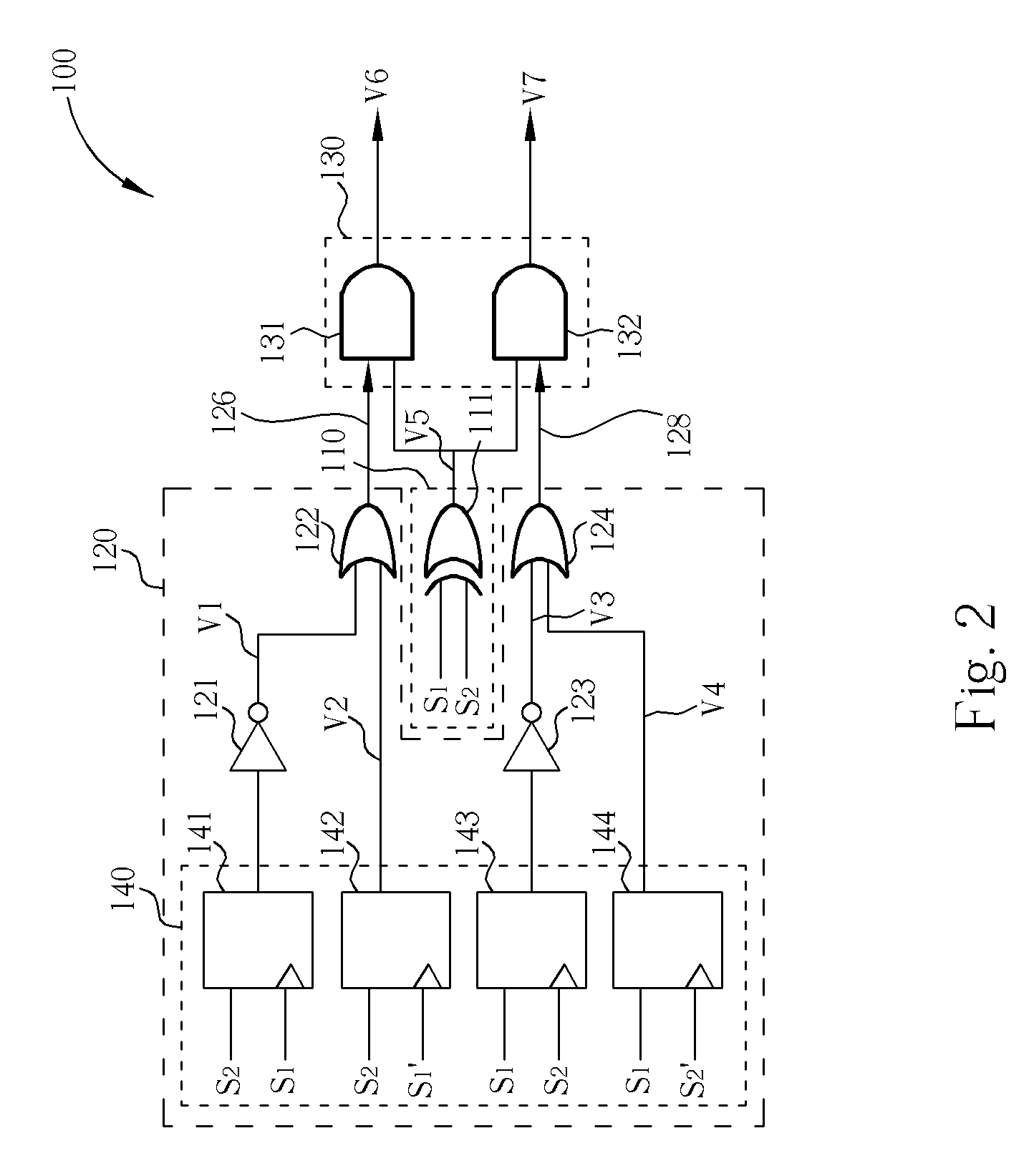Phase detector and related phase detecting method thereof
a phase detector and phase detection technology, applied in the direction of oscillator comparator circuits, angle demodulation by phase difference detection, electrical devices, etc., can solve problems such as continuous errors in the result of phase detection
- Summary
- Abstract
- Description
- Claims
- Application Information
AI Technical Summary
Benefits of technology
Problems solved by technology
Method used
Image
Examples
first embodiment
[0025] Please refer to FIG. 2 and FIG. 3. FIG. 2 is a diagram of the phase detector 100 of a first embodiment according to the present disclosure. FIG. 3 is a diagram of waveforms of signals shown in FIG. 2. As shown in FIG. 2, the phase detector 100 comprises a plurality of logic gates and flip-flops. The operation and function of the logic gates and the flip-flops will be illustrated in the following disclosure.
[0026] As shown in FIG. 2, the difference determining module 110 comprises an XOR logic gate 111, which receives the two signals S1 and S2. The XOR logic gate 111 performs an XOR operation upon the two signals S1 and S2. Therefore, in FIG. 3, the XOR logic gate 111 outputs a pulse if the two signals correspond to different logic levels (shown as the signal V5).
[0027] In one embodiment, the sampling module 140 comprises four D-type flip-flops 141, 142, 143, and 144, which respectively receive the two signals S1 and S2. Here, the D-type flip-flop 141 is illustrated first. Th...
second embodiment
[0033] Please refer to FIG. 4 and FIG. 5. FIG. 4 is a diagram of the phase detector 100 of a FIG. 5 is a diagram of waveforms of signals shown in FIG. 4. As shown in FIG. 4, the phase detector 100 comprises a plurality of logic gates and flip-flops.
[0034] Primarily, in FIG. 4, the operations and the functions of the devices having the same number as the devices shown in FIG. 2 also perform similar functions. In this embodiment, the only difference is that AND logic gates 422 and 424 are utilized to replace the OR logic gates 122 and 124 shown in FIG. 2. Therefore, an AND operation is performed upon the outputs of the NOT logic gate 121 and the D-type flip-flop 142. In other words, in this embodiment, when the signals V1 and V2 both correspond to 1, this means that the signal S1 leads the signal S2 such that the detection signal 126 outputted by the AND logic gate 422 corresponds to 1. Otherwise, the detection signal 126 corresponds to 0. On the other hand, when the signals V3 and V...
third embodiment
[0038] Surely, there is another way to determine the phase relationship. For example, in the case where the OR gates 122 and 124, and the AND gates 422 and 424 cannot be utilized, another method must exist. Please refer to FIG. 6, which is a diagram of the phase detector 100 of a In this embodiment, we can directly utilize the output of the D-type flip-flops 142 and 144 because they can react to the phase relationship. Similarly, the XOR gate 111 still determines the degree of the phase difference. Therefore, the voltage V6 and V7 respectively represents the leading / lagging phase difference.
[0039] Furthermore, we can utilize only half of the circuits. Please refer to FIG. 7, which is a diagram of a phase detector of a fourth embodiment. In this embodiment, only the D-type flip-flop 142 is used. Since one of the D-type flip-flop 142 or 144 is sufficient to determine the phase difference. That is, if the D-type flip-flop 142 outputs a high logic level 1, this means that the signal S1...
PUM
 Login to View More
Login to View More Abstract
Description
Claims
Application Information
 Login to View More
Login to View More - R&D
- Intellectual Property
- Life Sciences
- Materials
- Tech Scout
- Unparalleled Data Quality
- Higher Quality Content
- 60% Fewer Hallucinations
Browse by: Latest US Patents, China's latest patents, Technical Efficacy Thesaurus, Application Domain, Technology Topic, Popular Technical Reports.
© 2025 PatSnap. All rights reserved.Legal|Privacy policy|Modern Slavery Act Transparency Statement|Sitemap|About US| Contact US: help@patsnap.com



